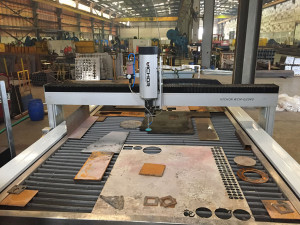
Automatic Water Jets: Revolutionizing Precision Cutting with High-Pressure Water
In the world of modern manufacturing and fabrication, precision, efficiency, and versatility are paramount. Among the advanced technologies that deliver on all these fronts, the automatic water jet stands out as a remarkably powerful and adaptable tool. This technology, which harnesses the immense power of water moving at supersonic speeds, has transformed how industries cut everything from soft foam to hardened titanium. But what exactly is an automatic water jet, how does it work, and what makes it so indispensable? This article delves deep into the mechanics, benefits, applications, and common considerations of this fascinating technology.
What is an Automatic Water Jet System?
At its core, an automatic water jet is a computer-numerically controlled (CNC) machine tool that uses a high-pressure stream of water, often mixed with an abrasive substance, to cut through materials. The term “automatic” is key here; it signifies that the entire cutting process is guided by sophisticated software, which translates a digital design file into precise movements of the cutting head. This automation eliminates human error, ensures exceptional repeatability, and allows for uninterrupted operation over long periods.
A basic system comprises three main components: the high-pressure pump, the cutting table, and the CNC control system. The pump intensifies water pressure to extreme levels—typically between 60,000 and 90,000 PSI—before forcing it through a tiny orifice in a jewel (like diamond or sapphire) to create a coherent, ultra-fast jet. For cutting harder materials, a granular abrasive (usually garnet) is introduced into the stream within a mixing tube, effectively turning the water into a potent cutting tool that erodes material away.
How Does an Automatic Water Jet Actually Work?
The principle behind an automatic water jet is deceptively simple yet incredibly effective. The process begins at the pump, where a regular municipal water supply is pressurized. This is most commonly done using a reciprocating intensifier pump that uses hydraulic power to create ultra-high water pressure.
The pressurized water is then delivered through high-pressure tubing to the cutting head. As it exits the orifice (which is only 0.010″ to 0.015″ in diameter), the potential energy of the pressurized water is converted into kinetic energy, accelerating the stream to speeds up to three times the speed of sound. In pure water jet cutting, this stream alone is sufficient to slice through soft materials like rubber, foam, food products, and textiles.
For metals, stone, glass, and composites, an abrasive automatic water jet system is used. The high-pressure water stream is passed through a venturi chamber in the cutting head, which creates a vacuum that draws in abrasive particles. These particles are accelerated by the water stream, creating a focused erosive action that cuts through the material. The CNC system meticulously moves this cutting head along the X and Y axes over the stationary material lying on the cutting table, faithfully following the path dictated by the digital design.
The Unmatched Advantages of Using an Automatic Water Jet
The widespread adoption of automatic water jet technology is driven by a host of significant advantages it holds over other cutting methods like laser, plasma, or mechanical cutting.
Cold Cutting Process: Unlike thermal cutting processes, a water jet does not generate heat. This eliminates the risk of heat-affected zones (HAZ), which can alter the material’s metallurgical properties, cause hardening, or create thermal stress and distortion. This makes it ideal for cutting explosives, heat-sensitive materials, and tempered glass.
Material Versatility: This is perhaps its greatest strength. An automatic water jet can cut virtually any material. From the softest plastics and foams to the hardest superalloys, granite, and ceramics, the same machine can handle a vastly diverse range of jobs without needing retooling.
High Precision and Quality: CNC automation ensures extreme accuracy, often within a tolerance of ±0.003 inches. The kerf (width of the cut) is very narrow, and the edge quality is typically excellent, often requiring no secondary finishing operations.
No Tooling Changes: There are no custom dies or tooling required. Switching from cutting aluminum to cutting stone simply involves loading a new file into the software. This drastically reduces setup time and cost, especially for prototyping and short production runs.
Environmentally Friendly: The process produces no hazardous fumes or gases. The primary waste is wet abrasive and slurry, which is generally inert and can often be recycled or disposed of safely.

Common Applications Across Industries
The unique capabilities of the automatic water jet have made it a critical asset in numerous sectors.
Aerospace: Used for cutting intricate parts from aluminum, titanium, and advanced composites without compromising the material’s structural integrity.
Architecture and Art: Perfect for creating detailed designs in marble, granite, glass, and metal for decorative panels, signage, and sculptures.
Automotive: Employed for prototyping parts, cutting gaskets, interior components (like carpets and headliners), and even body panels.
Food Industry: Pure water jets are used for hygienic, cold-cutting of frozen foods, cakes, pastries, and ready-to-eat products.
Manufacturing: A go-to solution for machine shops and fabricators for its ability to handle one-off jobs and large production runs with equal ease.
Navigating Common Questions and Challenges
While powerful, operating an automatic water jet is not without its considerations. Here are some common questions and challenges users face.
1. What is the typical operating cost?
The primary consumables are water, electricity, the orifice jewel, the mixing tube, and abrasive garnet. The abrasive can account for a significant portion of the running cost, though its consumption is managed by the CNC system. Pump maintenance is also a periodic cost to ensure consistent pressure.
2. How fast can an automatic water jet cut?
Cutting speed varies dramatically based on material type and thickness. It can quickly slice through soft materials but will move slower through thick, hard metals. The trade-off is between speed and edge quality; slower cuts produce smoother edges.
3. What about taper and how is it mitigated?
A inherent characteristic of waterjet cutting is that the jet can widen slightly as it travels through the material, resulting in a cut that is slightly wider at the top than the bottom (taper). Modern automatic water jet systems employ sophisticated software compensation (like taper compensation algorithms) and dynamic cutting head control to tilt the head and eliminate this effect, producing perfectly straight edges.
4. How is nozzle wear managed?
The orifice and mixing tube are subject to wear from the high-pressure and abrasive stream. Regular inspection and replacement schedules are essential to maintain cut quality and accuracy. Advanced systems monitor hours of use to predict maintenance needs.
5. Is the noise and maintenance a significant issue?
Water jets are loud, often requiring operators to wear hearing protection. The environment can be wet and messy. Furthermore, maintaining the ultra-high-pressure pump requires specialized knowledge and training, making it crucial to have a reliable service plan.
The evolution of the automatic water jet continues. Future trends point towards even greater automation, with integrated robotics for loading and unloading parts. Developments in pump technology aim for higher pressures with improved energy efficiency. Software is becoming more intelligent, with better algorithms for optimizing cutting paths, reducing abrasive consumption, and predicting maintenance needs. The integration of AI and IoT for predictive analytics and fully connected smart factories is the next frontier, ensuring that the automatic water jet remains a cornerstone of advanced manufacturing for years to come.
In conclusion, the automatic water jet is a testament to the power of harnessing nature’s simple element with sophisticated engineering. Its ability to cut virtually any material with cold, precise, and uncontaminated results makes it an invaluable and flexible tool across a breathtaking array of industries. By understanding its operation, benefits, and common challenges, businesses can fully leverage this revolutionary technology to enhance their capabilities and drive innovation.
continue reading
Related Posts
- 1371 words6.9 min read
- 1449 words7.3 min read



